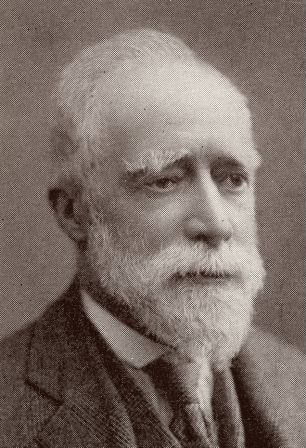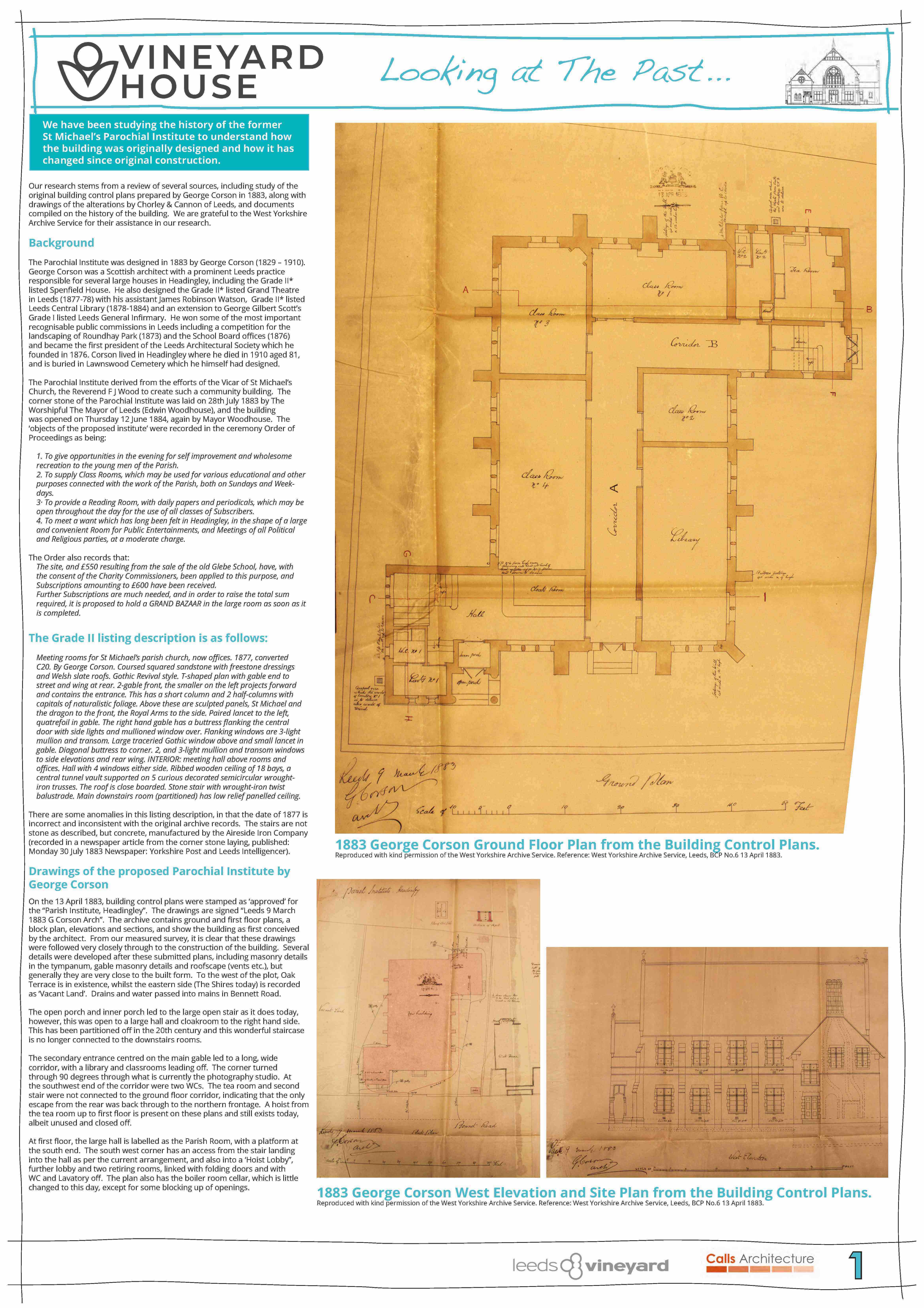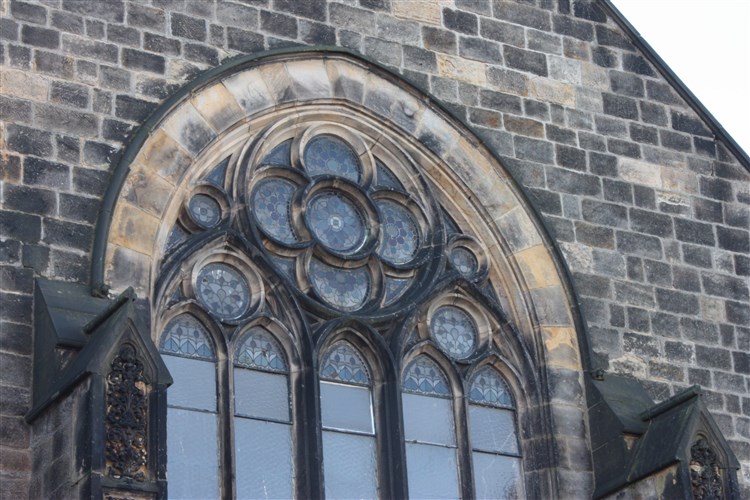History of the building
We had a sense of God’s provision when the building became available to the church community to purchase. And as we’ve discovered more we have begun to appreciate more fully the significance of the building, it’s heritage and previous relationship with the community. We hope to be able to unite the local community not only with a great community space again but by sharing memories of lives lived in the building down the generations.
History of the building and its architect George Corson
 A previous building for the Parish meetings rooms had existed, but the site was sold in 1875 and demolished. A new building, known as The Parochial Institute was constructed by George Corson in 1884. George Corson, born in Dumfries in 1829, came to Leeds in 1849 and by 1860 had his own Architectural practice. He was responsible for some of the most impressive municipal buildings of the Victorian era in the city of Leeds – including the magnificent Grand Theatre and the Central Library building with its spectacular Tiled Hall. He won some of the most important recognisable public commissions in Leeds including Roundhay Park (1873), School Board offices (1876) and the Leeds Infirmary extension (1891) and became the first president of the Leeds Architectural Society which he founded in 1976. Corson lived in Headingley where he died in 1910 aged 81.
A previous building for the Parish meetings rooms had existed, but the site was sold in 1875 and demolished. A new building, known as The Parochial Institute was constructed by George Corson in 1884. George Corson, born in Dumfries in 1829, came to Leeds in 1849 and by 1860 had his own Architectural practice. He was responsible for some of the most impressive municipal buildings of the Victorian era in the city of Leeds – including the magnificent Grand Theatre and the Central Library building with its spectacular Tiled Hall. He won some of the most important recognisable public commissions in Leeds including Roundhay Park (1873), School Board offices (1876) and the Leeds Infirmary extension (1891) and became the first president of the Leeds Architectural Society which he founded in 1976. Corson lived in Headingley where he died in 1910 aged 81.
According to the West Yorkshire Archive Service, the “objects of the proposed Institute” were: -
-
To give opportunities in the evening for self-improvement and wholesome recreation to the young men of the Parish.
-
To supply Class Rooms, which may be used for various educational and other purposes connected with the work of the Parish, both on Sundays and Week-days.
-
To provide a Reading Room, with daily papers and periodicals, which may be open throughout the day for the use of all classes of Subscribers.
-
To meet a want which has long been felt in Headingley, in the shape of a large and convenient Room for Public Entertainments, and Meetings of all Political and Religious parties, at a moderate charge.
After World War 2 (c. Sept 1946) the British Legion occupied part of the building, other rooms were used for various community activities and in 1984 it was sold and converted into offices.

Architectural Presentation Boards
 The appointed architect for Vineyard House, Stephen Dixon from Calls Architecture has produced some wonderful boards, we hope you enjoy reading more of the history of the former St Michael’s Parochial Institute and it is an honour and privilege to showcase original architectural drawings by George Corson.
The appointed architect for Vineyard House, Stephen Dixon from Calls Architecture has produced some wonderful boards, we hope you enjoy reading more of the history of the former St Michael’s Parochial Institute and it is an honour and privilege to showcase original architectural drawings by George Corson.
Architectural Presentation Boards

Grade II listed descriptions
You may be interesting to learn of the specific listings for the building as recorded with English Heritage, they are as follows;
 Meeting rooms for St Michael’s parish church, now offices. 1877, converted C20. By George Corson. Coursed squared sandstone with freestone dressings and Welsh slate roofs. Gothic Revival style. T-shaped plan with gable end to street and wing at rear. 2-gable front, the smaller on the left projects forward and contains the entrance. This has a short column and 2 half-columns with capitals of naturalistic foliage. Above these are sculpted panels, St Michael and the dragon to the front, the Royal Arms to the side. Paired lancet to the left, quatrefoil in gable. The right hand gable has a buttress flanking the central door with side lights and mullioned window over. Flanking windows are 3-light mullion and transom. Large traceried Gothic window above and small lancet in gable. Diagonal buttress to corner. 2, and 3-light mullion and transom windows to side elevations and rear wing. INTERIOR: meeting hall above rooms and offices. Hall with 4 windows either side. Ribbed wooden ceiling of 18 bays, a central tunnel vault supported on 5 curious decorated semi-circular wrought-iron trusses. The roof is close boarded. Stone stair with wrought-iron twist balustrade. Main downstairs room (partitioned) has low relief panelled ceiling.
Meeting rooms for St Michael’s parish church, now offices. 1877, converted C20. By George Corson. Coursed squared sandstone with freestone dressings and Welsh slate roofs. Gothic Revival style. T-shaped plan with gable end to street and wing at rear. 2-gable front, the smaller on the left projects forward and contains the entrance. This has a short column and 2 half-columns with capitals of naturalistic foliage. Above these are sculpted panels, St Michael and the dragon to the front, the Royal Arms to the side. Paired lancet to the left, quatrefoil in gable. The right hand gable has a buttress flanking the central door with side lights and mullioned window over. Flanking windows are 3-light mullion and transom. Large traceried Gothic window above and small lancet in gable. Diagonal buttress to corner. 2, and 3-light mullion and transom windows to side elevations and rear wing. INTERIOR: meeting hall above rooms and offices. Hall with 4 windows either side. Ribbed wooden ceiling of 18 bays, a central tunnel vault supported on 5 curious decorated semi-circular wrought-iron trusses. The roof is close boarded. Stone stair with wrought-iron twist balustrade. Main downstairs room (partitioned) has low relief panelled ceiling.

Historical events that took place in the building
We have been digging around in the British Newspaper Archives and love the varied and interesting events that took place in the building during the time when it was available for community use. Here are a selection;
Wednesday 10th December 1884
Annual public concert of the Headingley Vocal Society (Published Leeds Mercury)
Tuesday 3rd November 1891
Pincushion Exhibition - A novel show. The latest novelty in the form, a sale of works. 1,3000 pin cushions of all sorts and sizes on show. (Published Yorkshire Evening Post)
Saturday 7th November 1896
Several meetings are being held under the auspices of the Leeds Women’s Suffrage Society, at which addresses have been delivered by Mrs Philip, organising secretary of the National Society for Women’s Suffrage. On Wednesday Mrs Philip spoke at a meeting in the Headingley Parochial Institute and, in the course of her address, said there was some public questions which appealed especially to the sense of motherhood innate in women. She referred particularly to child insurance and baby farming. (Published Leeds Times)
From 1890s – 1900s lots of political meetings
Wednesday 18th January 1905
A pleasant drawing room entertainment, organised for the Leeds Invalid Children’s Aid Society. (Published Yorkshire Evening Post and Leeds Intelligencer)
Friday 12th January 1934
Children’s entertainment in aid of Leeds Infirmary. (Published Leeds Mercury)